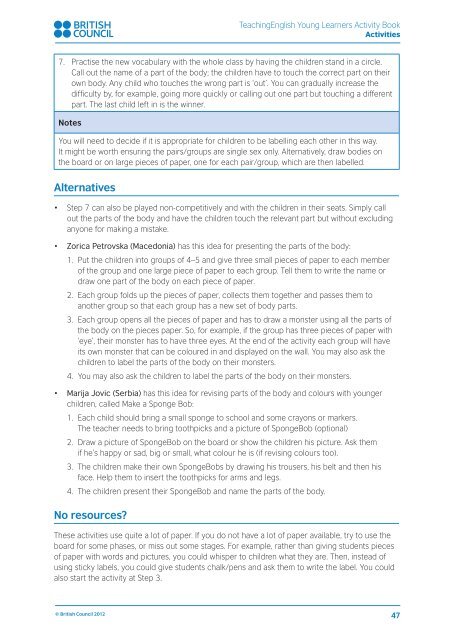url?sa=t&source=web&cd=3&ved=0CC0QFjAC&url=http://www.teachingenglish.org.uk/sites/teacheng/files/B369-Young-Learners-Activity-Book_v10
url?sa=t&source=web&cd=3&ved=0CC0QFjAC&url=http://www.teachingenglish.org.uk/sites/teacheng/files/B369-Young-Learners-Activity-Book_v10
url?sa=t&source=web&cd=3&ved=0CC0QFjAC&url=http://www.teachingenglish.org.uk/sites/teacheng/files/B369-Young-Learners-Activity-Book_v10
You also want an ePaper? Increase the reach of your titles
YUMPU automatically turns print PDFs into web optimized ePapers that Google loves.
TeachingEnglish <strong>Young</strong> <strong>Learners</strong> <strong>Activity</strong> <strong>Book</strong><br />
Activities<br />
7. Practise the new vocabulary with the whole class by having the children stand in a circle.<br />
Call out the name of a part of the body; the children have to touch the correct part on their<br />
own body. Any child who touches the wrong part is ‘out’. You can gradually increase the<br />
difficulty by, for example, going more quickly or calling out one part but touching a different<br />
part. The last child left in is the winner.<br />
Notes<br />
You will need to decide if it is appropriate for children to be labelling each other in this way.<br />
It might be worth ensuring the pairs/groups are single sex only. Alternatively, draw bodies on<br />
the board or on large pieces of paper, one for each pair/group, which are then labelled.<br />
Alternatives<br />
• Step 7 can also be played non-competitively and with the children in their seats. Simply call<br />
out the parts of the body and have the children touch the relevant part but without excluding<br />
anyone for making a mistake.<br />
• Zorica Petrovska (Macedonia) has this idea for presenting the parts of the body:<br />
1. Put the children into groups of 4–5 and give three small pieces of paper to each member<br />
of the group and one large piece of paper to each group. Tell them to write the name or<br />
draw one part of the body on each piece of paper.<br />
2. Each group folds up the pieces of paper, collects them together and passes them to<br />
another group so that each group has a new set of body parts.<br />
3. Each group opens all the pieces of paper and has to draw a monster using all the parts of<br />
the body on the pieces paper. So, for example, if the group has three pieces of paper with<br />
‘eye’, their monster has to have three eyes. At the end of the activity each group will have<br />
its own monster that can be coloured in and displayed on the wall. You may also ask the<br />
children to label the parts of the body on their monsters.<br />
4. You may also ask the children to label the parts of the body on their monsters.<br />
• Marija Jovic (Serbia) has this idea for revising parts of the body and colours with younger<br />
children, called Make a Sponge Bob:<br />
1. Each child should bring a small sponge to school and some crayons or markers.<br />
The teacher needs to bring toothpicks and a picture of SpongeBob (optional)<br />
2. Draw a picture of SpongeBob on the board or show the children his picture. Ask them<br />
if he’s happy or sad, big or small, what colour he is (if revising colours too).<br />
3. The children make their own SpongeBobs by drawing his trousers, his belt and then his<br />
face. Help them to insert the toothpicks for arms and legs.<br />
4. The children present their SpongeBob and name the parts of the body.<br />
No resources?<br />
These activities use quite a lot of paper. If you do not have a lot of paper available, try to use the<br />
board for some phases, or miss out some stages. For example, rather than giving students pieces<br />
of paper with words and pictures, you could whisper to children what they are. Then, instead of<br />
using sticky labels, you could give students chalk/pens and ask them to write the label. You could<br />
also start the activity at Step 3.<br />
© British Council 2012<br />
47





